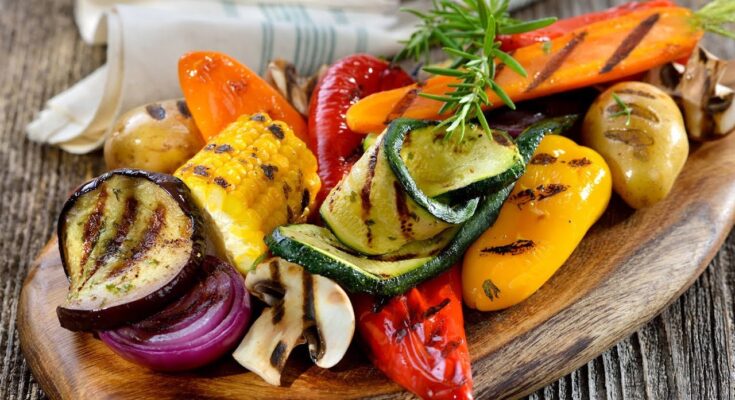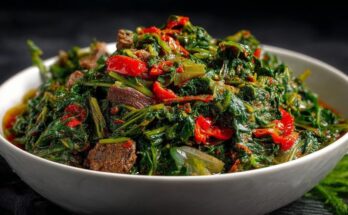Grilled Vegetables Recipe: Ever wonder how to make your vegetables taste like a dream? Grilling them is the answer. There’s something magical about the smoky, charred flavor that a grill adds to even the simplest of veggies. Whether you’re a vegetarian, vegan, or just trying to eat healthier, grilled vegetables are your best friend. They’re super versatile, can be served hot or cold, and pair well with just about any main dish.
One of the top reasons to love grilled veggies is how easy they are to customize. You can go Mediterranean-style with olive oil, garlic, and oregano, or spice things up with chili flakes and cumin. Grilling doesn’t just cook your veggies—it transforms them. It caramelizes their natural sugars, creating a sweet, smoky taste that’s irresistible.
Plus, grilling isn’t just for summer. With indoor grill pans or electric grills, you can enjoy this flavorful treat year-round. Whether you’re prepping a BBQ platter or adding them to tacos or grain bowls, grilled vegetables are a delicious and colorful way to upgrade your plate.
Health Benefits of Grilled Vegetables
Not only are grilled veggies tasty, but they’re also incredibly good for you. First off, grilling helps retain more nutrients compared to boiling or frying. Since you’re cooking them quickly over high heat, essential vitamins like A, C, and K stick around longer.
Also, because you’re using minimal oil—just enough to prevent sticking and help with seasoning—grilled veggies are naturally low in fat and calories. They’re rich in antioxidants, fiber, and essential minerals, making them a powerhouse addition to any meal.
Another bonus? They support digestion and keep you feeling full longer. Fiber-rich vegetables like zucchini, bell peppers, and eggplants can aid in gut health and help stabilize blood sugar levels.
If you’re watching your diet or simply want to eat more plant-based meals, grilled vegetables offer the perfect blend of flavor and nutrition. So yes, this dish is guilt-free and gratifying!
Best Vegetables for Grilling
Top Choices for Grilling
Some vegetables just shine on the grill. The heat brings out their sweetness, softens their texture, and gives them that desirable char. Here are some top picks that perform like stars on the grill:
- Bell Peppers: Red, yellow, and orange varieties get beautifully sweet when grilled.
- Zucchini & Summer Squash: These slice easily into planks or rounds and cook fast.
- Eggplant: Absorbs marinades like a sponge and becomes tender and meaty.
- Mushrooms: Especially portobello and cremini—they take on a smoky richness.
- Asparagus: Thin stalks grill quickly and add crunch to your plate.
- Onions: Sweet and caramelized when grilled in rings or wedges.
- Corn on the Cob: Grilled directly in husk or foil, corn becomes juicy and sweet.
- Tomatoes: Cherry tomatoes on skewers or halved Roma tomatoes get juicy and jammy.
Grilling these veggies brings out their depth and adds a texture that can’t be matched by steaming or baking.
Vegetables to Avoid on the Grill
Not every veggie is grill-friendly. Some are just too delicate or watery to hold up to direct heat. Here’s a list of ones you might want to skip:
- Leafy greens like spinach or arugula—they’ll wilt and burn almost instantly.
- Cucumbers—they’re too watery and turn mushy.
- Celery—its high water content and fibrous texture make it a poor griller.
- Radishes—they lose their crispness and can turn bitter.
- Cauliflower florets—they tend to fall apart unless pre-steamed or cut into thick steaks.
If you’re determined to grill a tricky veggie, consider using foil packets or grill baskets to keep them together and prevent them from falling through the grates.
Preparing Your Vegetables
Washing and Cutting Techniques
Preparation is half the battle when it comes to grilling vegetables. Start with fresh, firm produce—no wilting or soggy spots. Wash everything under cold running water and pat dry with paper towels. Removing moisture is crucial because excess water causes steaming, not grilling.
Next up is cutting. Think about surface area: the more contact with the grill, the better the flavor. For example:
- Slice zucchini and eggplant lengthwise into ¼-inch thick planks.
- Cut bell peppers into wide strips.
- Chop onions into thick rings or wedges.
- Leave mushrooms whole or halved for large ones.
- Trim asparagus ends and keep them whole.
Uniform thickness ensures everything cooks at the same rate. Don’t go too thin, or you’ll risk burning or falling through the grill grates.
Marinating for Maximum Flavor
This is where the magic happens. Marinating not only boosts flavor—it also keeps your veggies moist while they cook. A basic marinade includes:
- ¼ cup olive oil
- 2 tablespoons balsamic vinegar or lemon juice
- 2 cloves minced garlic
- Salt and pepper to taste
- Optional herbs: thyme, rosemary, oregano, or basil
Toss your chopped vegetables in a large bowl with the marinade and let them sit for at least 20–30 minutes. Want to go bold? Try a spicy marinade with soy sauce, chili flakes, and sesame oil, or a Mediterranean blend with lemon, garlic, and oregano.
Always drain off excess marinade before grilling to avoid flare-ups. You can brush a little more on as they grill for extra flavor layers.
Tools and Equipment You’ll Need
Grilling Essentials
You don’t need a backyard kitchen to make amazing grilled veggies, but a few tools make the job easier:
- Grill (gas, charcoal, or electric) – your heat source.
- Grill tongs – for flipping and moving food without piercing it.
- Grill basket or skewers – great for smaller items like cherry tomatoes or mushrooms.
- Basting brush – for applying extra marinade.
- Oil spray or brush – to prevent sticking.
Charcoal grills give that authentic smoky flavor, but gas grills offer convenience and control. Both can produce great results.
Optional Tools for Better Results
- Instant-read thermometer – not essential, but handy if you’re mixing veggies with meats.
- Grill mats or foil – ideal for fragile vegetables or easy cleanup.
- Cutting board and chef’s knife – for precise and even cutting.
- Vegetable basket – makes flipping easier and prevents pieces from falling through.
You can absolutely grill with just the basics, but these extras add efficiency and keep your grilling session frustration-free.
Step-by-Step Guide to Grilling Vegetables
Step 1: Preheat the Grill
The first step in grilling vegetables like a pro is to preheat your grill. This is where many people go wrong—they throw the veggies on a cold or lukewarm grill and end up with soggy, undercooked results. Preheating ensures that you get that initial sear, locking in flavors and juices from the get-go.
For gas grills, preheat on medium-high for about 10–15 minutes with the lid closed. If you’re using charcoal, wait until the coals are ashed over and glowing red, which also takes around 15–20 minutes. You’re aiming for a temperature of about 400–450°F (200–230°C).
Want a pro tip? Once your grill is hot, use a grill brush to clean the grates. Then, oil them lightly using a paper towel dipped in vegetable oil held with tongs. This prevents sticking and gives you those desirable grill marks.
Preheating also helps your vegetables cook evenly. When the grill is already hot, you won’t have to keep turning them endlessly to prevent burning. So don’t skip this crucial step—hot grill, happy veggies!
Step 2: Oil and Season Your Veggies
Once your veggies are sliced and the grill is preheated, it’s time to oil and season. This step is vital not just for taste but also to keep your vegetables from sticking to the grates and falling apart.
Here’s a foolproof method:
- Drizzle your vegetables lightly with olive oil—just enough to coat them.
- Toss them in a large bowl to distribute the oil evenly.
- Season generously with kosher salt and freshly cracked black pepper.
Want to take it up a notch? Add some garlic powder, smoked paprika, cumin, or Italian herbs to your seasoning mix. You can even use a squeeze of lemon or a splash of balsamic vinegar for added zing.
Don’t soak them in oil—just a thin coat will do. Too much oil can drip into the grill and cause flare-ups, which can char the outside while leaving the inside undercooked.
Keep your seasonings simple but bold. The grill will do most of the flavor work for you by caramelizing the sugars in the vegetables and giving them that amazing smoky depth.
Step 3: Time and Temperature Tips
Grilling vegetables is part science, part art. Different vegetables require different grill times and temperatures to cook perfectly. Knowing the right timing prevents burning or undercooking.
Here’s a cheat sheet to guide you:
| Vegetable | Grill Time (per side) | Total Time |
|---|---|---|
| Zucchini | 3–4 minutes | 6–8 mins |
| Bell Peppers | 4–5 minutes | 8–10 mins |
| Eggplant | 4–5 minutes | 8–10 mins |
| Asparagus | 2–3 minutes | 4–6 mins |
| Mushrooms | 4–5 minutes | 8–10 mins |
| Onions | 4–5 minutes | 8–10 mins |
| Corn on the Cob | 5–6 minutes | 10–12 mins |
Keep a close eye and flip the vegetables once you see nice grill marks forming. Use long-handled tongs to prevent burns and avoid piercing the veggies, which causes them to lose moisture.
Always use medium-high heat for most vegetables. Too high and they’ll burn on the outside and stay raw in the middle; too low and they’ll steam rather than grill.
Step 4: Grill to Perfection
Now comes the fun part—grilling! Place your vegetables directly on the hot grates, perpendicular to the bars to get those Insta-worthy grill marks. Don’t crowd the grill; give each piece enough room to cook evenly and get that nice char.
If you’re using a grill basket or skewers, make sure to rotate them gently and often to cook all sides. Remember, patience is key—avoid constant flipping or pressing down, which squeezes out all the juices.
Use your senses: the smell should be sweet and smoky, the texture should become tender with crisp edges, and the color should be vibrant with a few charred spots.
Once grilled to perfection, remove them immediately to avoid overcooking. You can always return them to the grill for a minute or two, but you can’t undo burnt veggies!
Here’s a trick: if you’re grilling a mix of vegetables, group them by cooking time so that nothing overcooks or undercooks. Start with denser ones like carrots and end with delicate ones like tomatoes.
Step 5: Serve and Garnish
Grilled vegetables are incredibly versatile. You can serve them hot off the grill as a side, toss them into salads, stuff them in sandwiches, or mix them with pasta or quinoa. The options are endless!
Before serving, give them a final flourish:
- Drizzle with balsamic glaze or lemon juice.
- Sprinkle with fresh herbs like basil, parsley, or thyme.
- Add crumbled feta, goat cheese, or grated Parmesan for extra richness.
- Toss with toasted nuts or seeds for crunch.
Want something heartier? Serve your grilled vegetables with hummus, tzatziki, or a garlic yogurt dip. You can even tuck them into warm pita or wraps for a light but satisfying meal.
Don’t forget to plate them beautifully. A vibrant spread of charred peppers, glistening zucchini, and smoky mushrooms is not just delicious—it’s visually stunning.
Creative Serving Ideas for Grilled Vegetables
Pairing with Proteins
Grilled vegetables are the ultimate sidekick for any main course, especially proteins. Whether you’re into meat, fish, or plant-based proteins, these smoky gems elevate every dish.
Pair your veggies with:
- Grilled chicken for a classic BBQ plate.
- Steak or lamb chops for a hearty and colorful meal.
- Grilled salmon or shrimp for a fresh, coastal vibe.
- Tofu or tempeh for a delicious vegetarian or vegan pairing.
The char and seasoning from the veggies contrast beautifully with juicy, savory proteins. Want an extra kick? Brush everything with the same marinade or spice blend so your plate is harmoniously flavored.
Also, you can make skewers with alternating chunks of veggies and meats like sausage or halloumi. It’s a great option for parties or casual dinners where everyone gets their own stick of goodness.
Incorporating Into Salads and Bowls
Grilled vegetables are a salad’s best friend. They add warmth, depth, and texture to your leafy greens. Toss grilled zucchini, eggplant, and bell peppers with arugula, cherry tomatoes, and feta for a Mediterranean salad.
Or go for grain bowls:
- Base: quinoa, farro, rice, or couscous.
- Protein: chickpeas, grilled chicken, or tofu.
- Veggies: grilled mix of your favorites.
- Dressing: tahini lemon sauce, balsamic vinaigrette, or chimichurri.
These bowls are meal-prep friendly and customizable to fit any diet. They’re also an awesome way to use up leftovers in a fun and healthy way.
Stuffed in Wraps or Sandwiches
Turn your grilled vegetables into a portable meal by stuffing them in wraps or sandwiches. Go Mediterranean with hummus, cucumber, and grilled eggplant in a pita. Or try a baguette with goat cheese, grilled peppers, and fresh basil.
Want something hearty? Stack grilled veggies with pesto and mozzarella on ciabatta bread, then press it in a panini maker or skillet for a crispy, melty treat.
Wraps and sandwiches are ideal for lunchboxes, picnics, or quick weeknight dinners. Plus, you can make them ahead and serve them cold or reheated.
Storing and Reheating Grilled Vegetables
Best Practices for Storage
Grilled vegetables are meal-prep superstars. To store them properly:
- Let them cool completely.
- Transfer to an airtight container.
- Refrigerate for up to 4–5 days.
Use separate containers if you’re storing strong-smelling veggies like onions or garlic-heavy marinades. That way, they won’t overpower the rest.
To freeze, lay them out in a single layer on a baking sheet, freeze until solid, then transfer to freezer bags. They’ll keep for up to 3 months, but keep in mind that texture may change slightly upon thawing.
Always label your containers with the date so you don’t forget when you made them!
How to Reheat Without Losing Flavor
When reheating grilled vegetables, avoid the microwave if you want to keep that grilled texture. Instead:
- Oven: Bake at 375°F for 10–15 minutes.
- Skillet: Sauté on medium heat until warmed through.
- Air fryer: Reheat for 5–7 minutes at 350°F for crisp edges.
If you do use the microwave, cover loosely and heat in short bursts to avoid sogginess.
Revive their flavor by adding a fresh squeeze of lemon juice or a sprinkle of herbs before serving. You can also mix in a dash of your favorite spice blend or a drizzle of olive oil to liven them up again.
Grilled Vegetables for Special Diets
Keto, Paleo, and Vegan-Friendly
Grilled vegetables check the box for almost every diet out there. They’re naturally:
- Low-carb and keto-friendly (zucchini, peppers, mushrooms).
- Whole30 and paleo-approved when cooked with compliant oils and spices.
- Vegan and vegetarian by default—just skip cheese-based garnishes.
This makes them ideal for serving at potlucks, BBQs, or dinners where guests have different dietary needs. Everyone can dig in and enjoy them without worry.
Plus, you can easily modify the marinade to fit any diet:
- Use avocado oil instead of olive oil for paleo.
- Skip soy sauce and opt for coconut aminos for Whole30.
- Add nutritional yeast instead of Parmesan for a cheesy vegan flavor.
No matter the diet, grilled vegetables offer a safe, satisfying, and flavorful option.
FAQs about Grilled Vegetables Recipe
Q1: Can I grill frozen vegetables?
A: It’s best to use fresh vegetables for grilling. Frozen veggies release too much water and may steam rather than grill. If you must use them, thaw and pat dry thoroughly before grilling.
Q2: How do I keep my vegetables from sticking to the grill?
A: Preheat the grill properly and brush the grates with oil. Also, coat your veggies lightly in oil to create a barrier between them and the grill.
Q3: Can I grill vegetables on a stovetop?
A: Absolutely! Use a grill pan or cast-iron skillet to mimic outdoor grilling. You’ll get nice char marks and a good sear.
Q4: How do I know when my vegetables are done?
A: They should be tender but still have some bite, with visible grill marks. Use a fork to test doneness and avoid overcooking.
Q5: What’s the best oil to use for grilling vegetables?
A: Olive oil is a classic choice, but you can also use avocado oil, grapeseed oil, or any oil with a high smoke point.
Conclusion
Grilled vegetables are more than just a healthy side—they’re a celebration of color, flavor, and simplicity. With just a few tools, some fresh produce, and a little seasoning, you can transform everyday veggies into a smoky, caramelized feast that’s perfect for any occasion.
Whether you’re firing up the grill for a backyard BBQ, meal prepping for the week, or looking to spice up your lunch bowl, grilled vegetables fit the bill. They’re easy to make, endlessly customizable, and pleasing to almost every palate.
So next time you’re in the kitchen (or on the patio), don’t overlook the veggie section. A good grill can turn even the humblest zucchini into the star of the show.



